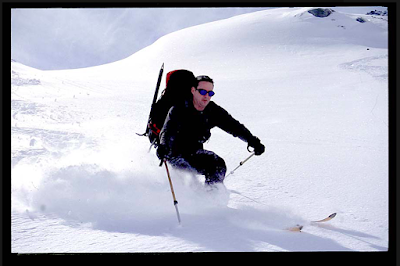Again, the New York Times demonstrates its unfailingness. In a recent edition of the NYT magazine, novelist Heidi Julavis writes up an avalanche course that she attended in January last year. What she learned was that avalanches from on high aren’t the primary threat. In nine accidents out of ten, the avalanche is triggered by the victims themselves.
 |
| Shredding it: a decision-maker on Piz Calderas (Photo courtesy of Alpine Light & Structure) |
“The problem” she writes “is that people are susceptible, prideful, bullheaded, egotistic, dumbstruck and lazy. Add to this doomed slurry a little avalanche training (or what used to qualify as avalanche training, and its focus on analyzing the snowpack) and people make terrible decisions with greater frequency and confidence.”
Her course instructor confirms this bleak analysis. The demographic most likely to die in an avalanche, he says, is male, late 20s, intermediate-to-expert skiing experience, combined with some formal avalanche training.
As if to ram this point home, a friend texts to Julavis a newspaper article posted on the very afternoon that her course ends. The headline reads: “Colorado’s first avalanche death of 2019 came during an advanced avalanche-safety course on Red Mountain Pass.”
Why is it that experts fall victim to avalanches as often – or perhaps more often – than novices do?
In her write-up, Julavis refers to Human Factor 2.0, a “seminal” 2016 article by David Page about the trend in avalanche education towards better decision-making. Page, in turn, cites six human factors identified by a previous researcher into avalanche accidents. These “decision-making traps” make up the acronym FACETS:
Familiarity: I’ve skied this line a dozen times and it’s always held.
Acceptance: I’m not gonna be the one to chicken out/ruin the day.
Commitment/consistency: Now we’ve come so far, we might as well carry on.
Expert halo: The guide or the local guy must know what he’s doing.
Tracks/scarcity: Let’s shred this untouched powder before somebody else does.
Social facilitation/proof: Those other guys are shredding it – clearly, it’s safe.
Page goes on to cite an expert who explains that, for novices, any gains they make in learning to analyse snow are still going to be fraught with lots of uncertainty. “So we’re teaching people risk-management systems that accommodate uncertainty. We’re trying to get away from teaching people to think they know things they don’t, to teaching people how to make reasonable decisions, assuming many sources of error in the system.”
A long time ago, a veteran Swiss alpinist put matters more succinctly: “Remember,” he said, “the avalanche doesn’t know you are an expert.”
No comments:
Post a Comment